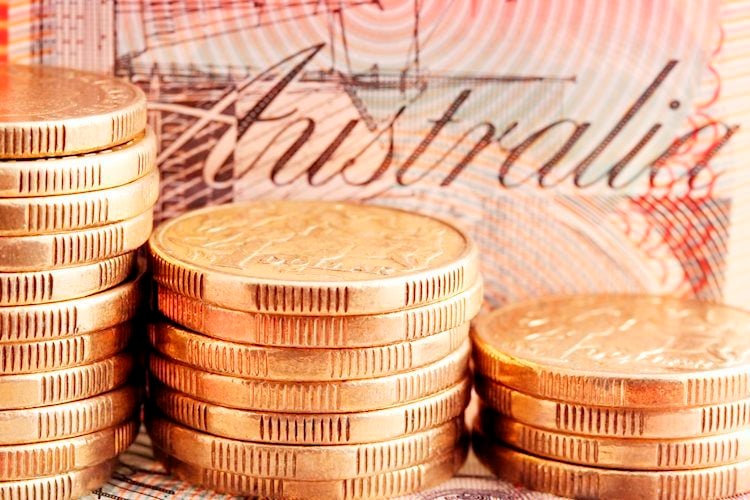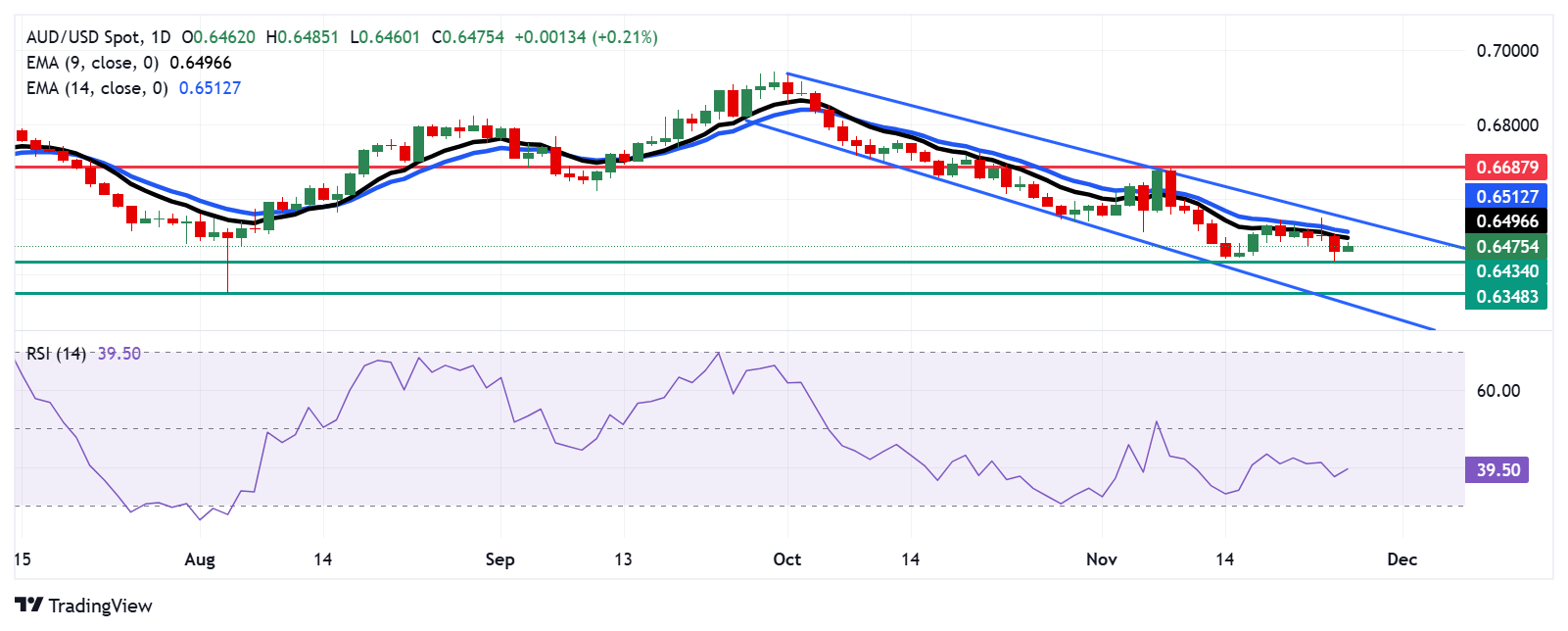- The Australian Dollar gains ground as the US Dollar remains subdued amid bond market optimism.
- Australia’s Monthly Consumer Price Index remained consistent at a 2.1% rise YoY in October, against an expected 2.3% increase.
- November’s FOMC Meeting Minutes indicated that policymakers are adopting a cautious stance on rate cuts.
The Australian Dollar (AUD) halts its three-day losing streak on Wednesday as the US Dollar (USD) remains subdued amid bond market optimism. Additionally, the Reserve Bank of Australia’s (RBA) hawkish outlook on future interest rate decisions provides support for the AUD. Traders await the US Personal Consumption Expenditure (PCE) Price Index and quarterly Gross Domestic Product Annualized scheduled to be released later in the North American session.
Australia’s monthly Consumer Price Index (CPI) rose by 2.1% year-over-year in October, unchanged from the previous month but below market expectations of 2.3%. This marked the lowest inflation rate since July 2021 and remained within the central bank’s target range of 2-3% for the third consecutive month.
The upside of the AUD/USD pair could be restrained due to dampened market sentiment following President-elect Donald Trump’s announcement of a 10% increase in tariffs on all Chinese goods entering the United States (US). Given that both countries are close trade partners, any change in China’s economy would impact Australian markets.
China’s Ambassador to Australia remarked on Tuesday that “US policy on trade with China and other countries will have an impact.” The Ambassador highlighted China’s expectation for dialogue with the US to address trade policies and explore ways to manage their bilateral relationship effectively.
Australian Dollar receives support from hawkish sentiment surrounding the RBA
- The latest Federal Open Market Committee’s (FOMC) Meeting Minutes for the policy meeting held on November 7, indicated that policymakers are adopting a cautious stance on cutting interest rates, citing easing inflation and a robust labor market.
- US President-elect Donald Trump is expected to appoint Jamieson Greer as the US Trade Representative, Bloomberg reported on Tuesday. Greer’s nomination highlights the central role of tariffs in Trump’s economic strategy.
- Chicago Fed President Austan Goolsbee indicated on Tuesday that the Fed is likely to continue lowering interest rates toward a neutral stance that neither stimulates nor restricts economic activity. Meanwhile, Minneapolis Fed President Neel Kashkari highlighted that it remains appropriate to consider another rate cut at the Fed’s December meeting, according to Bloomberg.
- US bond market gains ground as US President-elect Donald Trump selected the fund manager Scott Bessent as the US Treasury secretary, a seasoned Wall Street figure and fiscal conservative.
- The recent preliminary S&P Global US Purchasing Managers’ Index (PMI) data have reinforced expectations that the Federal Reserve (Fed) may slow the pace of rate cuts. Futures traders are now assigning a 57.7% probability to the Federal Reserve cutting rates by a quarter point in December, according to the CME FedWatch Tool.
- Australia’s four largest banks are predicting the Reserve Bank of Australia’s first rate cut. Westpac has revised its forecast for the first cut to May, up from February. National Australia Bank (NAB) also expects the cut in May. Meanwhile, the Commonwealth Bank of Australia (CBA) and ANZ are cautiously forecasting a rate cut in February.
Technical Analysis: Australian Dollar rises toward nine-day EMA near 0.6500
The AUD/USD pair hovers near 0.6470 on Wednesday, with technical analysis of the daily chart suggesting strengthening short-term bearish momentum. The pair remains confined within a descending channel, while the 14-day Relative Strength Index (RSI) stays below 50, signaling persistent negative sentiment.
Regarding its support, the AUD/USD pair could test its four-month low of 0.6434 recorded on November 26. A break below this level could lead the pair to approach the yearly low of 0.6348, last reached on August 5, with additional support found near the descending channel’s lower boundary at 0.6320.
On the upside, the resistance lies at the nine-day Exponential Moving Average (EMA) of 0.6495 and the 14-day EMA of 0.6512. Further resistance appears at the upper boundary of the descending channel at the 0.6550 level. A decisive break above these levels could support the pair to explore the region around its four-week high of 0.6687.
AUD/USD: Daily Chart
Australian Dollar PRICE Today
The table below shows the percentage change of Australian Dollar (AUD) against listed major currencies today. Australian Dollar was the strongest against the Canadian Dollar.
| USD | EUR | GBP | JPY | CAD | AUD | NZD | CHF | |
|---|---|---|---|---|---|---|---|---|
| USD | 0.00% | -0.12% | -0.49% | 0.03% | -0.21% | -0.67% | -0.14% | |
| EUR | -0.01% | -0.13% | -0.48% | 0.02% | -0.22% | -0.68% | -0.16% | |
| GBP | 0.12% | 0.13% | -0.36% | 0.18% | -0.09% | -0.55% | -0.02% | |
| JPY | 0.49% | 0.48% | 0.36% | 0.52% | 0.27% | -0.19% | 0.35% | |
| CAD | -0.03% | -0.02% | -0.18% | -0.52% | -0.25% | -0.71% | -0.18% | |
| AUD | 0.21% | 0.22% | 0.09% | -0.27% | 0.25% | -0.45% | 0.06% | |
| NZD | 0.67% | 0.68% | 0.55% | 0.19% | 0.71% | 0.45% | 0.53% | |
| CHF | 0.14% | 0.16% | 0.02% | -0.35% | 0.18% | -0.06% | -0.53% |
The heat map shows percentage changes of major currencies against each other. The base currency is picked from the left column, while the quote currency is picked from the top row. For example, if you pick the Australian Dollar from the left column and move along the horizontal line to the US Dollar, the percentage change displayed in the box will represent AUD (base)/USD (quote).
Australian Dollar FAQs
One of the most significant factors for the Australian Dollar (AUD) is the level of interest rates set by the Reserve Bank of Australia (RBA). Because Australia is a resource-rich country another key driver is the price of its biggest export, Iron Ore. The health of the Chinese economy, its largest trading partner, is a factor, as well as inflation in Australia, its growth rate and Trade Balance. Market sentiment – whether investors are taking on more risky assets (risk-on) or seeking safe-havens (risk-off) – is also a factor, with risk-on positive for AUD.
The Reserve Bank of Australia (RBA) influences the Australian Dollar (AUD) by setting the level of interest rates that Australian banks can lend to each other. This influences the level of interest rates in the economy as a whole. The main goal of the RBA is to maintain a stable inflation rate of 2-3% by adjusting interest rates up or down. Relatively high interest rates compared to other major central banks support the AUD, and the opposite for relatively low. The RBA can also use quantitative easing and tightening to influence credit conditions, with the former AUD-negative and the latter AUD-positive.
China is Australia’s largest trading partner so the health of the Chinese economy is a major influence on the value of the Australian Dollar (AUD). When the Chinese economy is doing well it purchases more raw materials, goods and services from Australia, lifting demand for the AUD, and pushing up its value. The opposite is the case when the Chinese economy is not growing as fast as expected. Positive or negative surprises in Chinese growth data, therefore, often have a direct impact on the Australian Dollar and its pairs.
Iron Ore is Australia’s largest export, accounting for $118 billion a year according to data from 2021, with China as its primary destination. The price of Iron Ore, therefore, can be a driver of the Australian Dollar. Generally, if the price of Iron Ore rises, AUD also goes up, as aggregate demand for the currency increases. The opposite is the case if the price of Iron Ore falls. Higher Iron Ore prices also tend to result in a greater likelihood of a positive Trade Balance for Australia, which is also positive of the AUD.
The Trade Balance, which is the difference between what a country earns from its exports versus what it pays for its imports, is another factor that can influence the value of the Australian Dollar. If Australia produces highly sought after exports, then its currency will gain in value purely from the surplus demand created from foreign buyers seeking to purchase its exports versus what it spends to purchase imports. Therefore, a positive net Trade Balance strengthens the AUD, with the opposite effect if the Trade Balance is negative.


 RULE-BASED Pocket Option Strategy That Actually Works | Live Trading
RULE-BASED Pocket Option Strategy That Actually Works | Live Trading This “NEW CONCEPT” Trading Strategy Prints Money!… (INSANE Results!)
This “NEW CONCEPT” Trading Strategy Prints Money!… (INSANE Results!)